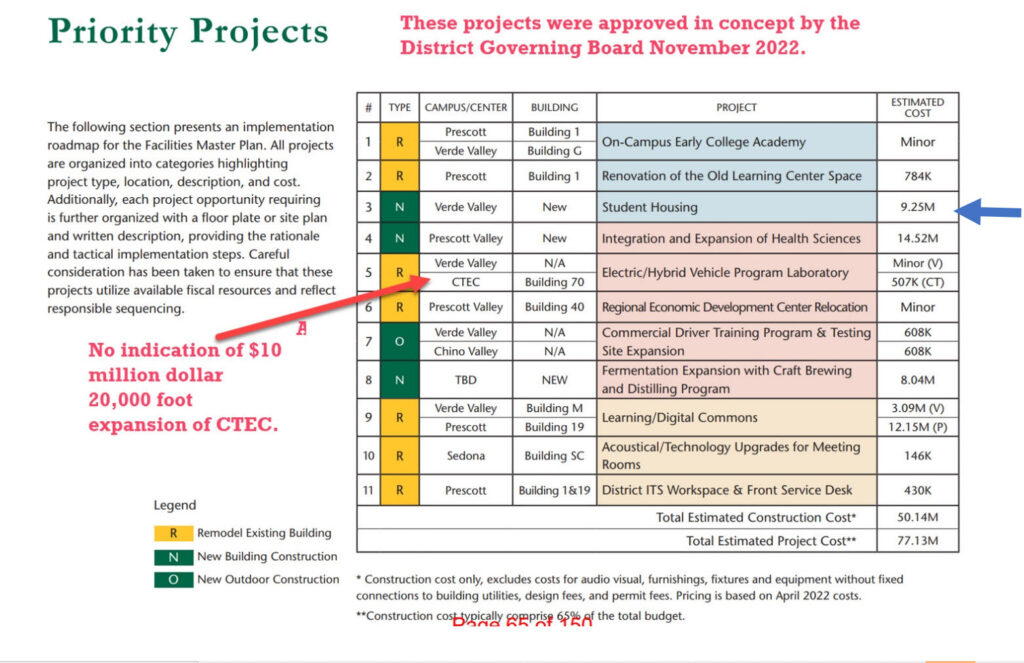Verde Valley/Sedona Residents taken by surprise as a variety of multi-million dollar projects for west side of County continue to be pulled from taxpayer hat by College execs while east side of County ignored

Robert Oliphant, Editor
EDITORIAL: The Yavapai Community College executives began laying the groundwork during the September 19 Board meeting for another multi-million dollar construction project on the Prescott side of Mingus mountain. This project would consist of a 40 apartment complex on 1.15 acres it just purchased near the Career and Technical Education Center. The College’s rhetoric during the meeting left little doubt to most listeners that the goal is to obtain swift approval for the project at the next budget opportunity.
The College’s unveiling of the possible multi-million-dollar apartment complex for CTEC comes as yet another surprising development for County residents. Recall the sudden last minute insertion of $10 million into the 2023-24 budget to accommodate a 20,000 foot expansion of CTEC—it already covers around 108,000 square feet. Then the August surprise announcement that the College was quickly moving forward with preliminary plans to construct a 30,000 square foot Health Science Center in Prescott Valley at a cost of at least $20 million.
In addition to these surprises, we know the College is currently allocating around $15 million to convert the Prescott Campus library into Digital Learning Commons. Moreover, it is in the process of developing a housing complex of manufactured homes near Prescott Valley for west side faculty, which will no doubt cost millions.
In stark contrast, the Community College’s allocation of resources and concern for housing and amenities on the Verde Valley Campus and Sedona Center is minimal at best. It scrapped the Master plan provision based on need and research, approved in concept by the Governing Board in November 2022, to invest $9.25 million in decent student housing on the Verde Valley Campus.
It is worth noting that the $9.25 million Verde Valley/Sedona campus housing project was labeled a priority in November 2022 and sold as such to local politicians by College representatives in a special meeting held months earlier in March 2022. Despite the Master plan and rhetoric associated with it, within a few weeks of the November presentation it appears the College stepped away from it in favor of cheap, inexpensive temporary housing fixes for the Verde Valley Campus/Sedona Center. Here are some concrete examples to illustrate this shift.
The first example is the decision to construct a crude 10 vehicle trailer park on the Verde Valley Campus. Starting last March, with notice to no one including the Third District representative, the College issued a contract, drafted a plan, and put a bulldozer to work on on the project. Grading began on some unused desert land on its Verde Valley Campus adjacent to the vineyard that is a block or more from the main Campus facilities. There are neither sidewalks nor well-developed walking paths between the trailer park and teaching facilities. Over the summer it installed a basic septic system plus water and electric lines, poured a small cement slab for each trailer, and proudly proclaimed in August the availability of a ten vehicle trailer lot for faculty and students.
By any measure, this is a minimalist trailer park. It offers little relief from the blistering summer heat because it lacks shade trees or a permanent structure for cooling, student gatherings, food, or refreshments. Security measures appear inadequate, outdoor lighting is nonexistent, regulations are few and far between, and perhaps most astonishingly, the trailer park entrance is merely 50 – 75 feet away from the backyards of Clarkdale residents. Access to the trailer park is via a poorly constructed, single-lane trail-type road where nightly visits from coyotes and Mohave rattlesnakes are far from uncommon, making for a rather unconventional coexistence with trailers of varying ages, makes, sizes, and conditions.
The second example involved cutting a deal during the summer of 2023 with a Prescott Valley developer who was building a large apartment complex in Cottonwood about two miles from the Verde Valley Campus. The College agreed to reserve ten apartments for faculty and students and then rent them out.
This apartment project has already failed. Despite its best efforts beginning in the summer, the scheme failed to attract either faculty or students to rent them from the College for the fall semester. Apparently, although not entirely clear, the developer let the College out of any cost associated with its reserve agreement for the fall semester. The project will be shuttered next year unless there are takers in January 2024.
One couldn’t help but smile as the College executives presented their case for the CTEC apartments at the September Board meeting. They attempted to tantalize the Governing Board with the prospect of partnering with a company with international headquarters in Copenhagen, Denmark, known by the acronym “COBOD” (Construct Buildings on Demand). This company aspires to sell 40 state-of-the-art 3D cement printing machines annually in the United States. The pitch to the Board by the College centered on the notion that Yavapai could serve as the ideal training ground for individuals who invest in these printers.
According to the sales pitch delivered on Tuesday, the COBOD trainees would require accommodation for a semester or possibly shorter periods. Thus, the subtle yet discernible suggestion to the Board that there is an essential need for housing these individuals near CTEC because this is a destination program. The destination claim is a familiar one that has been previously disregarded on numerous occasions in the case of the vineyard and culinary projects at the Verde Valley Campus and the Sedona Center respectively.
To further persuade the Governing Board, the College execs trotted out a graph showing that the potential student housing demand for CTEC-like-courses was already at 42. It was estimated that COBOD would add another ten people to this list.
One can’t help but ponder whether this entire endeavor was surreptitiously conceived in the offices of Yavapai Community College executives based in Prescott many months ago and intentionally kept hidden from the County’s residents. This approach now appears to be the commonly accepted modus operandi of the executives running this publicly funded educational institution.
They understand full well that without awareness by County residents of how they are spending taxpayer funds there is little or no accountability. After all, as someone has said, “accountability ascends amidst awareness.”

